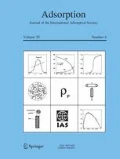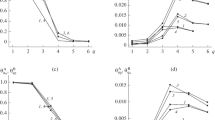Abstract
The solid–fluid (SF) interaction energy describes the affinity between one adsorbate molecule and a solid. Its quantification is an essential input for the simulation of the adsorption isotherm, the isosteric heat and details of the microscopic structure of the adsorbate. A good approximation to the SF energy can be obtained by direct summation of all effective pairwise interaction energies (LJ plus electrostatic) between an adsorbate molecule and all the atoms in the solid. To repeat this summation for each new configuration in a simulation is very time-consuming. One resolution is to construct database tables of the solid–fluid potentials, which leads to massive databases if the grid separation used is very small. For solids that have simple geometries an alternative is to determine the approximate solid–fluid potential by ignoring the discrete atomic structure of the solid. This level of approximation is adequate for many simulations of engineering interest where fine details, for example in the first adsorbate layer, are not necessary. In this paper, we report comprehensive derivations of solid–fluid potentials for a wide range of solids, in layered structures with constant surface atom density or solid structures with constant atom density, and various curvatures and dimensions. These solids are common in engineering applications and the derived analytical solutions will be of value to scientists and engineers. We take a finite solid as an example of the application of the SF potential equations developed in this paper, and show the spatial variation of the solid–fluid potential energy in the neighbourhood of the edges of the solid, which is found to be remarkably different from the usual 1D potential energy equation commonly used in the adsorption literature.








Similar content being viewed by others
References
Asai, M., Ohba, T., Iwanaga, T., Kanoh, H., Endo, M., Campos-Delgado, J., Terrones, M., Nakai, K., Kaneko, K.: Marked adsorption irreversibility of graphitic nanoribbons for CO2 and H2O. J. Am. Chem. Soc. 133(38), 14880–14883 (2011)
Bojan, M.J., Steele, W.A.: Computer simulation of physisorption on a heterogeneous surface. Surf. Sci. 199(3), 395–402 (1988)
Chandrakumar, K., Srinivasu, K., Ghosh, S.K.: Nanoscale curvature-induced hydrogen adsorption in alkali metal doped carbon nanomaterials. J. Phys. Chem. C 112(40), 15670–15679 (2008)
Cong, S., Sugahara, T., Wei, T., Jiu, J., Hirose, Y., Nagao, S., Suganuma, K.: Diverse adsorption/desorption abilities originating from the nanostructural morphology of VOC gas sensing devices based on molybdenum trioxide nanorod arrays. Adv. Mater. Interfaces 3(14), 1600252 (2016)
Crowell, A., Steele, R.: Interaction potentials of simple nonpolar molecules with graphite. J. Chem. Phys. 34(4), 1347–1349 (1961)
Everett, D.H., Powl, J.C.: Adsorption in slit-like and cylindrical micropores in the henry’s law region. A model for the microporosity of carbons. J. Chem. Soc. Faraday Trans. 72, 619–636 (1976)
Goler, S., Coletti, C., Tozzini, V., Piazza, V., Mashoff, T., Beltram, F., Pellegrini, V., Heun, S.: Influence of graphene curvature on hydrogen adsorption: toward hydrogen storage devices. J. Phys. Chem. C 117(22), 11506–11513 (2013)
Gor, G.Y., Rasmussen, C.J., Neimark, A.V.: Capillary condensation hysteresis in overlapping spherical pores: a Monte Carlo simulation study. Langmuir 28(33), 12100–12107 (2012)
Gotovac, S., Honda, H., Hattori, Y., Takahashi, K., Kanoh, H., Kaneko, K.: Effect of nanoscale curvature of single-walled carbon nanotubes on adsorption of polycyclic aromatic hydrocarbons. Nano Lett. 7(3), 583–587 (2007)
Nguyen, P.T., Do, D., Nicholson, D.: On the cavitation and pore blocking in cylindrical pores with simple connectivity. J. Phys. Chem. B 115(42), 12160–12172 (2011)
Nika, D., Pokatilov, E., Askerov, A., Balandin, A.: Phonon thermal conduction in graphene: role of Umklapp and edge roughness scattering. Phys. Rev. B 79(15), 155413 (2009)
Ohba, T.: Significant curvature effects of partially charged carbon nanotubes on electrolyte behavior investigated using Monte Carlo simulations. PCCP 18(21), 14543–14548 (2016)
Ohba, T., Kanoh, H.: Intensive edge effects of nanographenes in molecular adsorptions. J. Phys. Chem. Lett. 3(4), 511–516 (2012)
Radovic, L.R., Bockrath, B.: On the chemical nature of graphene edges: origin of stability and potential for magnetism in carbon materials. J. Am. Chem. Soc. 127(16), 5917–5927 (2005)
Rasmussen, C.J., Gor, G.Y., Neimark, A.V.: Monte Carlo simulation of cavitation in pores with nonwetting defects. Langmuir 28(10), 4702–4711 (2012)
Shen, A., Zou, Y., Wang, Q., Dryfe, R.A., Huang, X., Dou, S., Dai, L., Wang, S.: Oxygen reduction reaction in a droplet on graphite: direct evidence that the edge is more active than the basal plane. Angew. Chem. 126(40), 10980–10984 (2014)
Son, Y.-W., Cohen, M.L., Louie, S.G.: Half-metallic graphene nanoribbons. Nature 444(7117), 347–349 (2006)
Steele, W.A.: The physical interaction of gases with crystalline solids: I. Gas–solid energies and properties of isolated adsorbed atoms. Surf. Sci. 36(1), 317–352 (1973)
Steele, W.A.: The Interaction of Gases with Solid Surfaces. Pergamon, London (1974)
Tjatjopoulos, G.J., Feke, D.L., Mann, J.A. Jr.: Molecule-micropore interaction potentials. J. Phys. Chem. 92(13), 4006–4007 (1988)
Villarreal, E., Li, G.G., Zhang, Q., Fu, X., Wang, H.: Nanoscale surface curvature effects on ligand–nanoparticle interactions: a plasmon-enhanced spectroscopic study of thiolated ligand adsorption, desorption, and exchange on gold nanoparticles. Nano Lett. 17(7), 4443–4452 (2017)
Von Goeler, F., Muthukumar, M.: Adsorption of polyelectrolytes onto curved surfaces. J. Chem. Phys. 100(10), 7796–7803 (1994)
Vrabec, J., Stoll, J., Hasse, H.: A set of molecular models for symmetric quadrupolar fluids. J. Phys. Chem. B. 105(48), 12126–12133 (2001)
Wongkoblap, A., Do, D.D., Nicholson, D.: Explanation of the unusual peak of calorimetric heat in the adsorption of nitrogen, argon and methane on graphitized thermal carbon black. PCCP 10(8), 1106–1113 (2008)
Wu, C.-M., Baltrusaitis, J., Gillan, E.G., Grassian, V.H.: Sulfur dioxide adsorption on ZnO nanoparticles and nanorods. J. Phys. Chem. C. 115(20), 10164–10172 (2011)
Young, D., Crowell, A.: Physical Adsorption of Gases. Butterworths, London (1962)
Zeng, Y., Horio, K., Horikawa, T., Nakai, K., Do, D.D., Nicholson, D.: On the evolution of the heat spike in the isosteric heat versus loading for argon adsorption on graphite-A new molecular model for graphite and reconciliation between experiment and computer simulation. Carbon. 122, 622–634 (2017)
Acknowledgements
This project is supported by the Australian Research Council (DP16013540), and the scholarship from China Scholarship Council (CSC) for Lumeng Liu in spending his tenure at the University of Queensland.
Author information
Authors and Affiliations
Corresponding author
Electronic supplementary material
Below is the link to the electronic supplementary material.
Rights and permissions
About this article
Cite this article
Liu, L., Zeng, Y., Do, D.D. et al. Development of averaged solid–fluid potential energies for layers and solids of various geometries and dimensionality. Adsorption 24, 1–9 (2018). https://doi.org/10.1007/s10450-017-9921-2
Received:
Revised:
Accepted:
Published:
Issue Date:
DOI: https://doi.org/10.1007/s10450-017-9921-2




